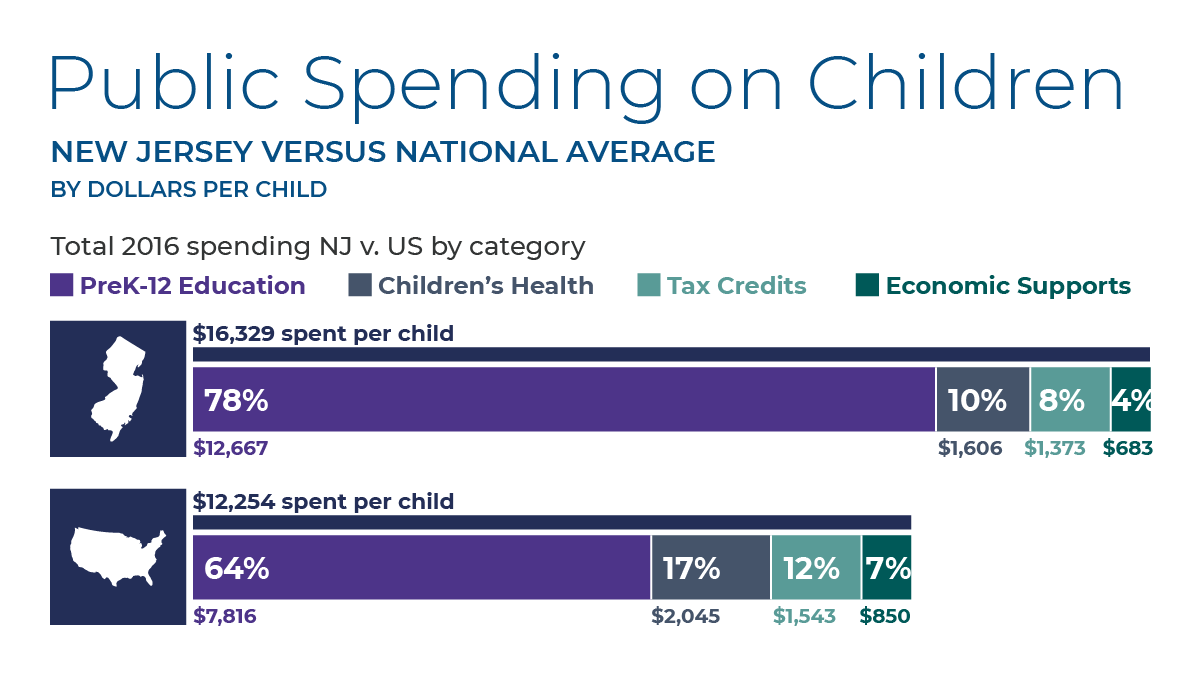Nicholson-Funded Analysis Finds New Jersey Spends Above the National Average on Children
An Urban Institute (UI) analysis finds that New Jersey spends substantially more public dollars on children 0-18 than the national average. Based on 2016 data—the latest available—expenditures for PreK-12 education, children’s health, child-related tax credits, and economic supports for families totaled $16,329 per child, or some $4,000 more on average than for all states combined.
More so, findings in this analysis, underwritten by The Nicholson Foundation, show that this higher rate of spending is due to New Jersey’s investment in public education. For instance, PreK-12 funding is nearly $5,000 more per child than other states and includes compensation for teachers and administrators, curriculum and instructional materials, early education provided through Head Start and state prekindergarten, school meals, transportation, facilities, and services delivered outside of public schools, such as early intervention and vocational education.
At the same time, New Jersey’s high rate of spending for public education is paying off: the state ranks first in PreK-12 education outcomes nationwide, according to the Annie E. Casey’s 2018 Kids Count assessment of preschool participation, fourth grade reading, eighth grade math, and high school graduation.
The UI findings are drawn from its State-by-State Spending on Kids Dataset, a comprehensive accounting of public spending on children from 1997 through 2016. It draws on the U.S. Census Bureau’s Annual Survey of State and Local Government Finances, as well as several federal and other noncensus sources.
As shown in the chart above, the analysis of 2016 data also finds that New Jersey’s spending on children differs significantly by category, with much higher expenditures for PreK-12 education than for health, child-related tax credits, and economic support for children and families.
Here are other key findings from the analysis:
- New Jersey spends similar amounts to its neighboring states, especially after adjusting for regional differences in the cost of living. Public investment per child in New Jersey is similar to total per child spending in Pennsylvania, slightly above spending in Connecticut, and below levels in Delaware and New York.
- New Jersey draws down less in federal dollars per child than the average state. In 2016, federal funding averaged $3,522 per child in New Jersey, compared to $4,376 per child in the United States overall. This is in striking contrast to New Jersey’s higher than average spending from state and local funding.
- New Jersey continues to outpace most neighboring states in spending on public PreK-12 education. Adjustments for cost of living put New Jersey’s PreK-12 spending at $11,170, above spending in three neighboring states, but still lower than New York ($11,948). New Jersey’s other public spending on children (a total of children’s health, tax credits, and economic supports) is in line with Connecticut ($3,229 versus $3,104), but well below that of other neighboring states.
- New Jersey spends less than average outside of education. While spending differences in children’s health, tax credits, and economic supports are small ($439, $170, and $167, respectively), they add up—especially for children in households with low incomes who may rely on more than one of these supports.

